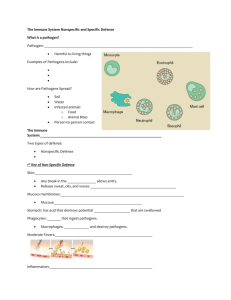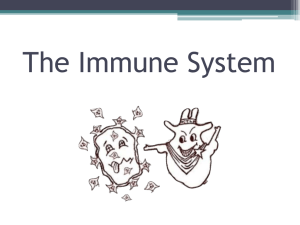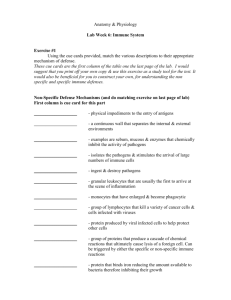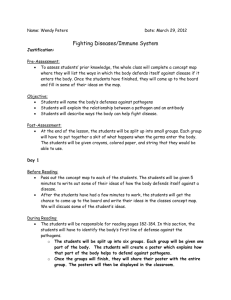Immune System
advertisement
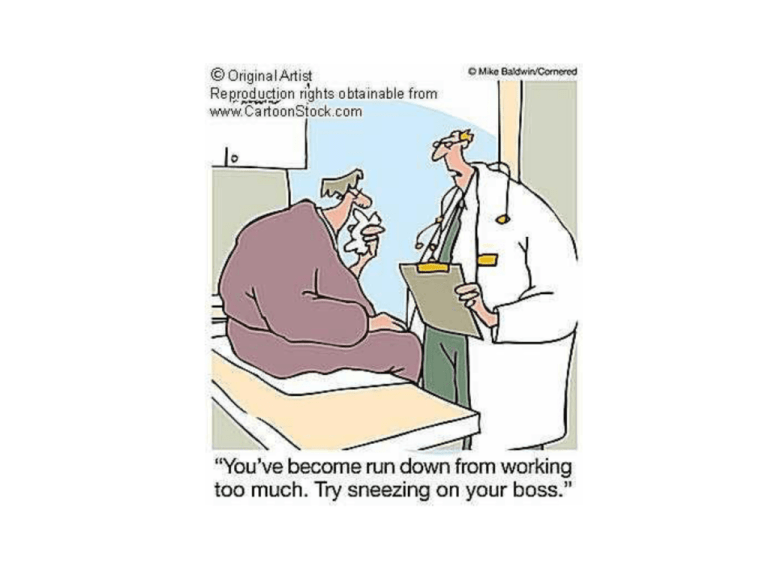
Immune System Immune System (IS) Your body’s defense against pathogens, or disease causing organisms 2 types of defense: 1) Non-specific defense 2) Specific defense Non-Specific Defense (NSD) • Body’s 1st line of defense • Guards against all infections • Not directed against any specific pathogen Examples of NSD 1) Skin - makes it hard for pathogens to enter the body - oil and sweat glands create acidic environment kills many pathogens Examples of NSD 2) Nose - mucus and nose hairs trap viruses and bacteria 3) Mouth/Trachea (throat area): - cilia (small hairs) trap bacteria and dust - cilia push pathogens up towards mouth or down towards stomach Examples of NSD 4) Stomach: - acids and digestive enzymes kill pathogens 5) Body Secretions: - mucus, saliva, sweat, tears contain lysozymes (enzymes that break down cell walls of bacteria) Examples of NSD Natural killer cells attacking an infected cell Macrophage eating bacteria 6) Natural Killer Cells: (T- lymphocytes) - patrol the body, killing infected cells in mass 7) Macrophages: - White blood cell that eat and clean-up dead cell debris and pathogens left by the killer cells - release interleukins Examples of NSD 8) Interleukins: - Slows down the body by causing it to ache - Signals reinforcement to help fight infection and starts specific defenses Interleukin-21 Examples of NSD 9) Inflammatory Response - When an infected area becomes swollen because fluids and macrophages leak into infected areas - Lymph nodes swell as they make more macrophages and lymphocytes 10) Fever - increases macrophage and lymphocyte production - kills pathogens - dilates (opens) blood vessels so cells of the IS can enter infected areas faster Examples of NSD 11) Interferons (special proteins released by virus-infected cells - they “interfere” with the virus’s ability to reproduce - slows viral infection rate and buys time for your body’s immune system to respond Specific Defenses of the IS If a pathogen is able to get past the NSD of the Immune System (IS), then the IS reacts by launching an attack on the specific pathogen in specific defense (SD) Key proteins in the SD system Antigens: Identifiable proteins found on the surface of a pathogen or foreign cell Antibody: Y-shaped molecule with two antigen binding sites Made by the “B-cells” of the IS Key Cells to the Specific Defense (SD) System 1) Macrophages 2) Dendritic Cells - Presents the antigens taken from pathogens to other cells of the immune system, such as the helper T-cells 3) Helper T- lymphocytes - recognizes antigens and stimulates other cells of the immune system (like B – lymphocytes) to fight the infection B T Key Cells to the Specific Defense (SD) System Y B Y Y 4) B – lymphocytes (B – cells) - Produce anti-bodies - Help remember the antigen - Mature in the bone marrow T • Each B – cell is specific in fighting one pathogen • B – cells, once activated by a helper T-cell, divides into a memory cell and millions of plasma cells. • Plasma B – cells make the antibodies • Memory B – cells “remember” the pathogen Key Cells to the Specific Defense (SD) System 5) Killer T – lymphocytes: - Searches and kills infected cells and cancer cells 6) Suppressor T-cells - Slows down the IS once the danger has passed What are the steps to the Specific Defense Immune Response? 1. Dendritic cells identify foreign antigens and presents them to the helper T-cells to start an immune response 2. Helper T-cells activate B - cells which make antibodies that fight the infection. B – cells also remember. 3. Antibodies bind to antigens of the foreign cells and causes them to “clump” and get marked for destruction What are the steps to the Specific Defense Immune Response? 4) Macrophages eat the clumped pathogens that are trapped by the antibodies 5) Killer T-cells destroy the remaining cells that are infected by the pathogens 6) Suppressor T cells slows down the IS
